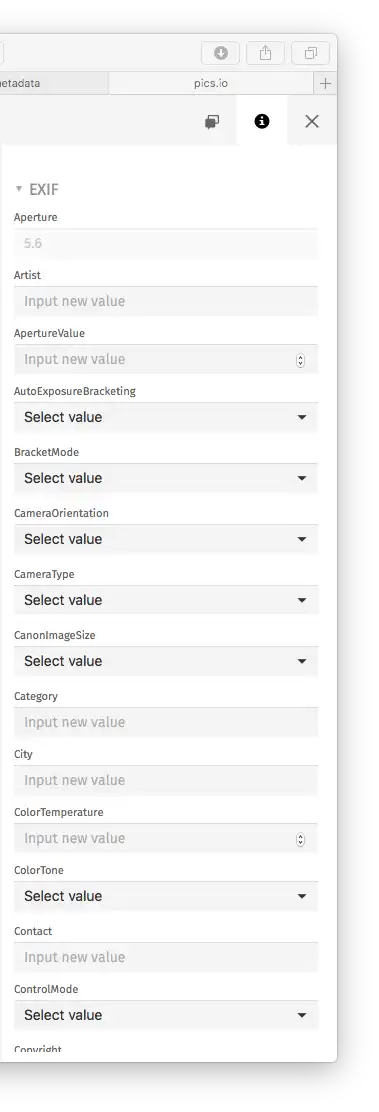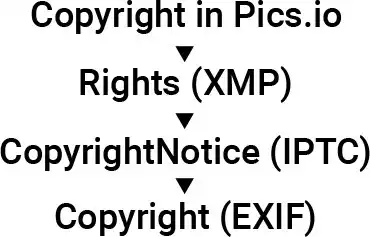In this article, you’ll learn:
Unveiling the intricacies behind the Pics.io metadata management tool
Updated April 2020
“Metadata lets us find our assets in a Digital Asset Management system. We could say that metadata is the engine that drives DAM,” Carl Seibert, consulting photo editor & metadata maven
What is an asset and how is it different from a file? What does metadata have to do with that? And why do we need a special metadata management system to deal with modern files?
The thing is the asset is NOT the same as a file. It’s much more than that and has its own data inside serving as its description. So-called, data about data. Here’s where metadata comes in place telling the story of your digital file and making it valuable for your business.
Let’s get deep inside the metadata story…

For example, if you simply look at the post image, you can only see a grumpy, slightly disheveled cat and some trees in the background. But, it’s not everything you can learn about it…
Who created it and when and where? Definitely this data can be easily accessed through the one-click on file. For example, when you click on this cat.jpg you see that the size of this file is 40+ plus KB, and it was last opened on Wednesday, April 2020 at 5:49 PM. If an asset like this photo has to be valuable in the future, we have to know some things about it.
But actually, this isn’t but the very tip of the iceberg…
What is metadata and why it is important?
Metadata refers to all sorts of additional information associated with your digital file. Another way to think of metadata is as a short explanation or summary of what is inside your file helping to find it in seconds. Metadata does not only tell you the story of your digital asset but also puts in control of it.
Metadata management is the administration of metadata in order to make it easier to access and retrieve content. It involves creating and managing a repository in which files are consistently tagged with the right metadata.
With the help of metadata you can:
- Find out who contributed this file to your database;
- See when the file was created & on which occasion;
- Be aware of any restrictions to its use;
- Know exactly who owns the copyright & when it expires;
- Find assets in your vast digital library & make a selection of files
In other words, metadata helps you identify & locate your files really fast. That’s why metadata is said to be as valuable as the content itself. Because what good is in the great image if you can never find it again?
But, why you might need any additional information within your digital asset?
In reality, metadata tags are really numerous and diverse, depending on the file format a number of different metatags are 1000 plus. Why anyone should care about these data?

The thing is that every digital document contains much more useful information inside. We can’t see it all on our usual devices. But if you open your photo in any Digital Assets Management service, such as Pics.io, you’ll see that your file contains a lot of technical details that are very meaningful and useful to you if you’re a photographer.
For example, a photo may contain information about the camera and its settings, such as aperture, speed, ISO, lens used, focal length, GPS location, etc. An audio file will probably show you a tracking number, genre, beats per minute, and lots of other technical details that may be very important for professionals.
Besides, metadata may contain copyright information, which is very important if you want to protect your work from illicit use.
So, when you have access to all this useful information embedded in your digital file, you are not dealing with a file anymore. You’re dealing with an Asset.
To utilize the value of this asset you have to be able to find it in the future and that is where metadata management tool like Pics.io DAM comes in place. If you have thousands of assets the value of DAM is inevitable. It allows you to see all the relevant metadata through the metadata viewer and to search for your assets by metadata. You can even modify the metadata, and these changes will be preserved within your asset and stay available elsewhere, beyond Pics.io.
Now, let us give you a little inside scoop into how Pics.io works with metadata.
Explore Pics.io metadata management tool
Actually, handling metadata a pretty tricky and confusing issue, for several reasons.
As we discussed above, metadata tags are extremely numerous and diverse. File formats are being constantly upgraded, and new ones appear regularly.
Secondly, there is no single standard for creating and processing metadata that would be obligatory for everybody. Several attempts have been made to classify a whole lot of metadata over the past twenty years — resulting in three most widely-recognized standards: EXIF, IPTC/IIM, and XMP.
XMP (which stands for Extensible Metadata Platform), which is the most recent standard, was meant to deprecate all the previous standards. However, it didn’t happen this way. Different software and different producers still apply different principles and often create their own tags.
As a result, there are a lot of overlapping fields that sometimes describe one and the same thing with different words. And there’s no feasible way to bring this all under control. A simple example is “Creator” in IPTC and “Artist” in EXIF that describe the same information. Or such fields as “Caption”, “Description”, and even “Caption/Abstract” that are also about the same stuff.

Clearly, it’s a huge pain in the neck for a DAM service. Which standard to prefer? How to make sure that the information is saved in the correct field? What if we miss something important? And finally — which metadata should be rewritable, and which should remain unchanged (such as the file size, for example)?…
Read more on EXIF/IPTC metadata at Pics.io.
We in Pics.io racked our brains a lot thinking of how we could make this chaos a bit more reasonable and relevant for our users. In the end, for lack of better judgment or reliable recommendations, we used our common sense and implemented metadata parsing the way we did, and it existed for quite a while…
… Until we received a friendly email from Carl Seibert, a long-time photo editor, and photojournalist who is a real enthusiast about everything connected with digital assets management and metadata. In his brilliant Metadata Matters blog, he really digs deep into this controversial domain. He tries to develop the best practices for metadata management and “get all the ducks in one row”, as he himself puts it.
Investigate best practices in metadata management with Pics.io DAM
Carl made — quite voluntarily — an extensive review of what Pics.io does with metadata, where we had it wrong, and where we missed something. In fact, he gave us the most useful and practical guidelines about metadata management that we could have ever asked for.
As a result, armed with this professional advice, we’ve overhauled the entire system of working with metadata in Pics.io. The sifted through all the metadata fields and introduced a number of clear and straightforward rules of how we parse metadata, show them on our interface, and how we preserve them in case of changes and alterations.
Now a few words about the new logic of handling metadata in Pics.io. Get ready for a bit of technical stuff.
So, how does Pics.io actually capture metadata from the digital file?
Basically, now in Pics.io we have one default rule and a number of specific rules for reading metadata. This strategy helped us to develop the perfect image metadata viewer and editor.
The default rule applies to fields that are the same across standards. For example, CreateDate, which is present everywhere and mean the same thing — the date when the file was created. With such fields, the default rule goes like this:
- First of all, we look at what’s written in this particular field (say, CreateDate) in XMP. Why XMP? Because it’s the most recent and advanced of all standards. So, if this group contains some information about the asset, there’s a strong probability that this information is the correct one. So, we take it.
- If XMP is empty, we move on to IPTC.
- And if IPTC is empty as well, we rely on what’s available in EXIF.
In a nutshell, the default sequence looks like this:

However, as we’ve mentioned before, not all the fields are the same across all the standards. So, we should apply some more sophisticated algorithms to them to make sure we capture all the relevant data.
To work with these fields, we’ve elaborated thirty-something specific rules. There’s no default sequence, and the algorithm looks a bit different for every field. For example, this is how it works with the field Title:
- Again, we start by looking at what’s written in the field Title in XMP.
- If there’s nothing there, we look at what’s available in the field Headline in IPTC.
- If there’s nothing there either, we capture what’s written in the field ObjectName in IPTC.
That was all about how Pics.io image metadata viewer works for the digital file. Now a big question arises…
What are the rules behind this process?
How does Pics.io metadata manager save changes in metadata?
The so-called writing rule in Pics.io works in a similar way as the reading order.
In the case of default fields (which are the same for all the standards) the modified info is saved everywhere, i.e. in all the fields that have the same name.
For example, if a user changes something in the field CreateDate, this change is saved in all the fields with this name across all the standards, be it XPM, IPTC, or EXIF.
But if the fields are called differently in different standards (as in the case with “Title”, the specific rules will apply. Pics.io will find the corresponding fields, even if they are called differently in different standards, and save the modified info there.
For example, if you change something in the field “Copyright”, this alteration will be saved in such fields as “Rights” (XMP), “CopyrightNotice” (IPTC), and “Copyright” (EXIF). So, no information will be lost, and you’ll find your metadata in every software you use.

So, this is the inner logic that works now in Pics.io. Of course, there’s no ultimate truth in the field of metadata management, as Carl Seibert himself says. But common sense, a bit of meticulousness, and best practices — all these finally make it work.
In this way, we’ve managed to bring order to the metadata chaos in Pics.io. No duplicate fields, and no missing fields either. And there’s a guarantee that the metadata you change is preserved in the appropriate fields, so that you can see it on other platforms, with other software.
How to customize metadata for your business?
Apart from embedded default metadata, you can create your own custom metadata fields that would reflect the specifics of your business. In other words, you can add extra fields where you will write specific information about your assets.
For example, if you run a retail business, you can create a field “Dimensions” where you can type in the real dimensions of the item you sell. This info will stay within the photo of the product.
In Pics.io, there are 5 types of metadata custom fields you can create: text, number, list, data, checkbox (yes/no question). This is where you start creating a set of custom metadata fields for your library. This task may seem daunting at first & take a couple of iterations before everything works like clockwork. But it’s all worth it. After all, every business is unique, with its own peculiarities and internal logic. And nobody knows your business better than you!
There’s no silver bullet for creating custom metadata. Yet, you may use some of these tips:
- Follow the rule of 5 W’s: Who, What, Where, When, Why. Whenever you upload a new file to your digital library, make sure you enter the necessary info. E.g. Who is the author of the photo? Where was it taken? When does the copyright license expire?
- Use keywords alongside custom metadata. Unlike metadata, these may cover some broader and subjective issues, which are not so easy to classify or break down into categories.
- Upload a pre-selected list of controlled vocabulary for keywords to keep them consistent.
- Use automatic AI keywording for the assets you need to know some basic info about.
Now that you understand how metadata can be beneficial for your business, it’s time to take action!
Efficient metadata management works best if you implement it with a professional Pics.io DAM solution. Here you can do both: find all embedded metadata & create unique custom fields for your line of business.
Efficient metadata management works best if you implement it with a professional Pics.io DAM solution. Here you can do both: find all embedded metadata & create unique custom fields for your line of business.
If you’re interested to learn more about how we handle metadata in Pics.io, and especially about how we apply those specific rules I’ve mentioned before — please investigate our Metadata Playbook for Business. We would also appreciate sharing your experience on metadata management with Pics.io DAM in the comments section below or on email.
If you haven’t registered yet, follow this link to create a free account.



